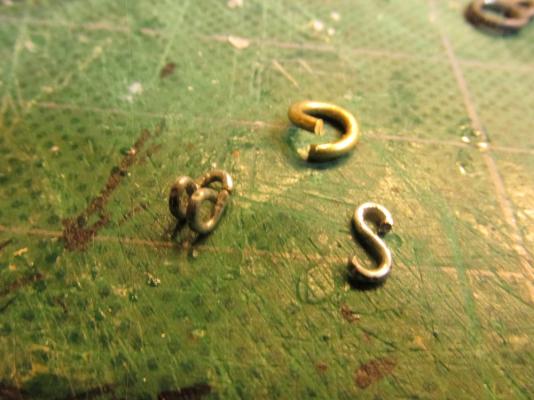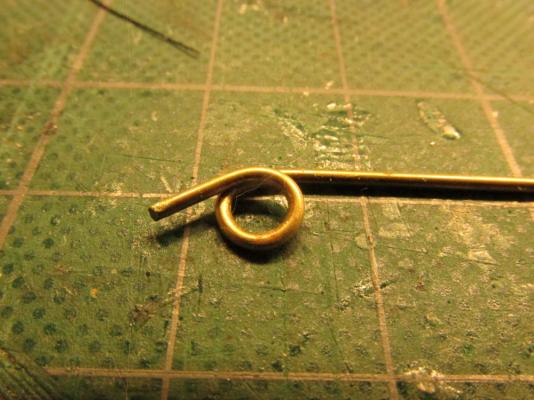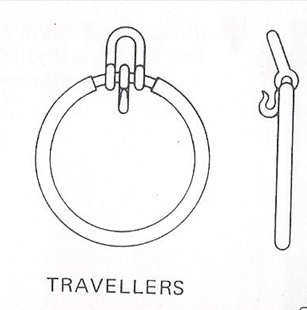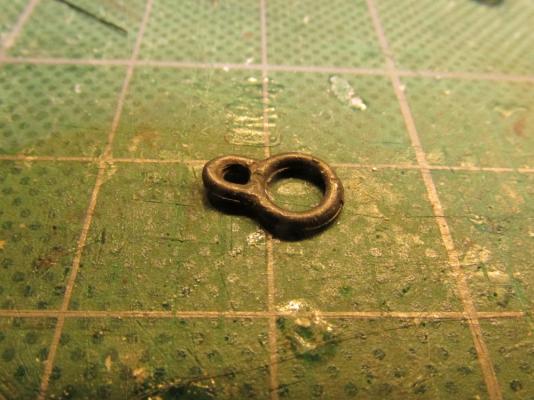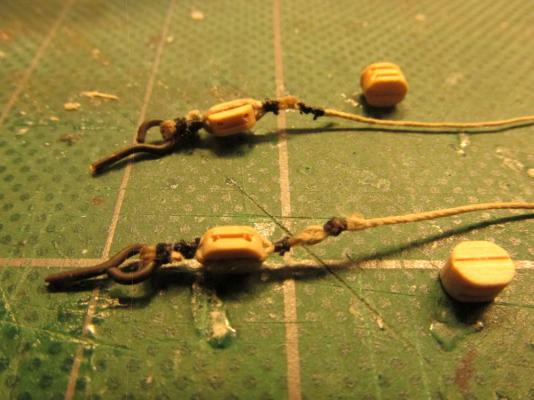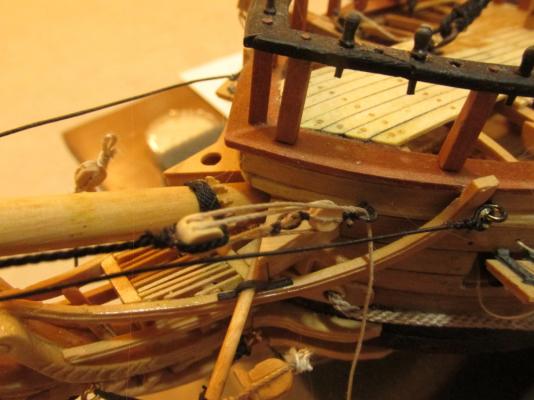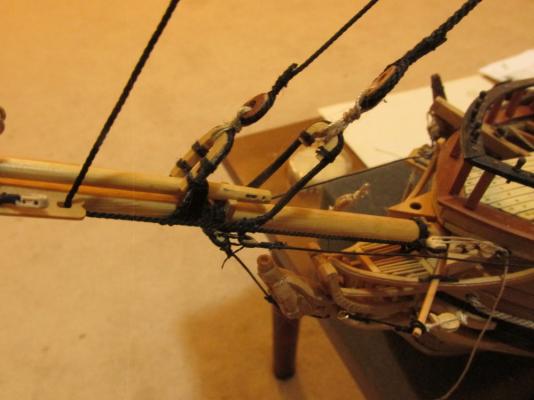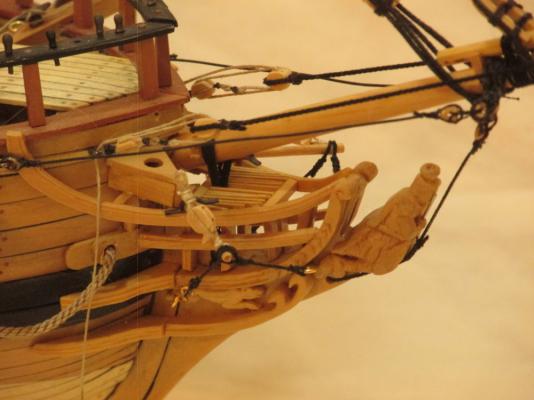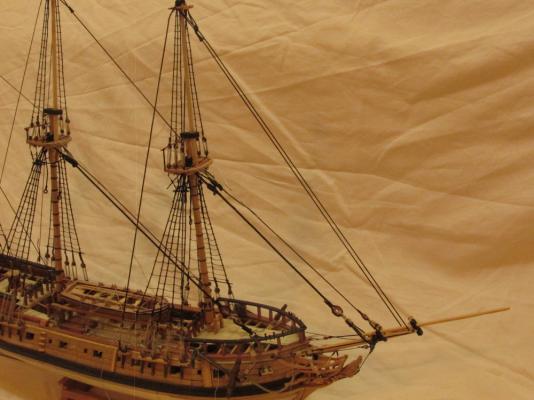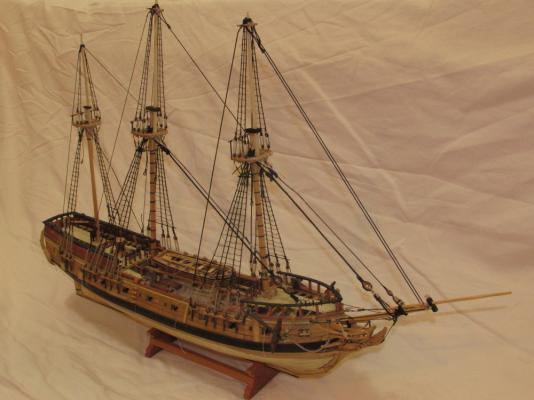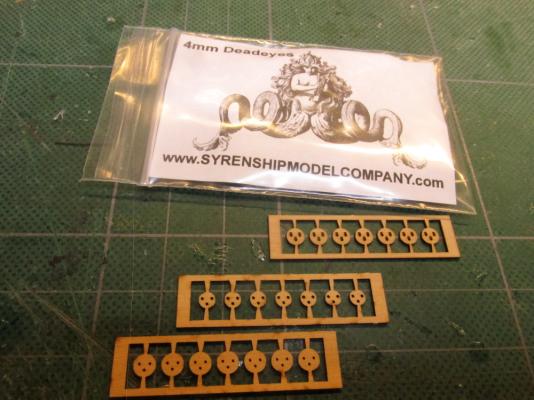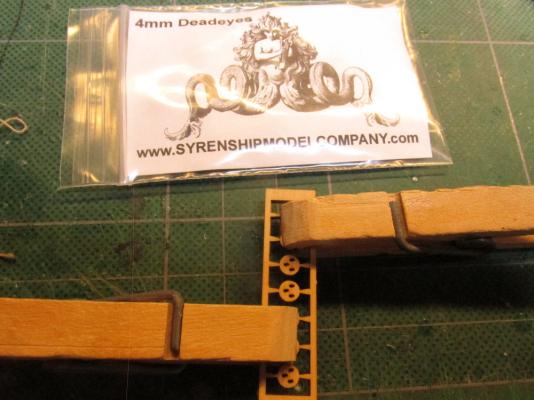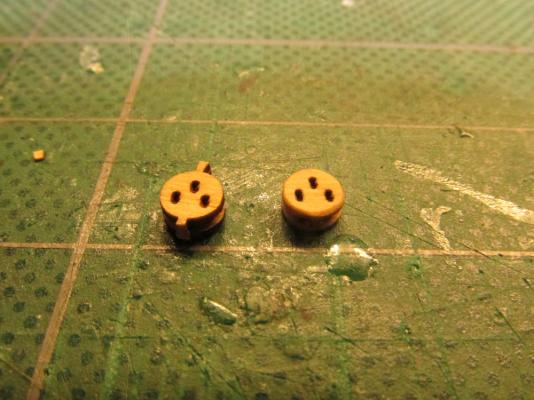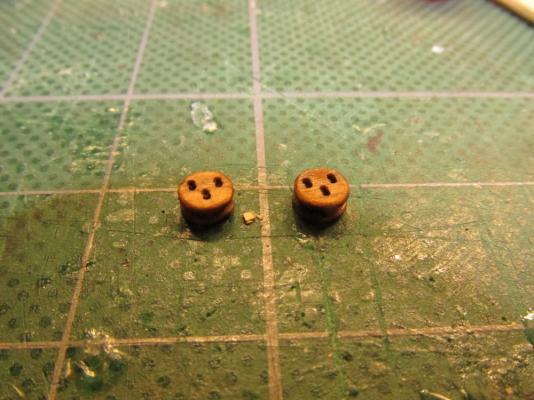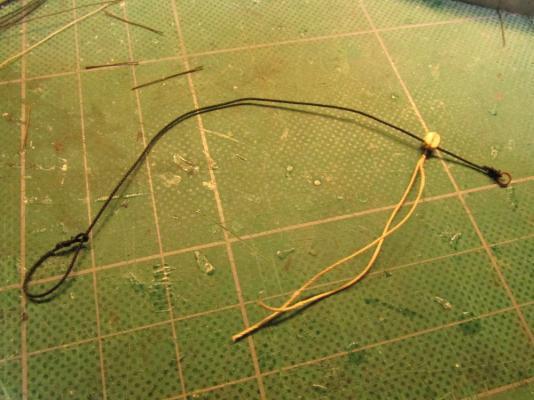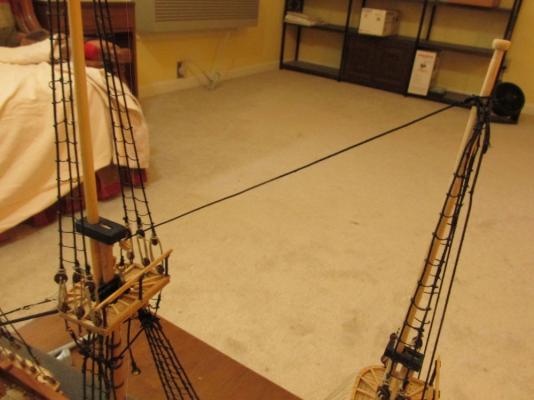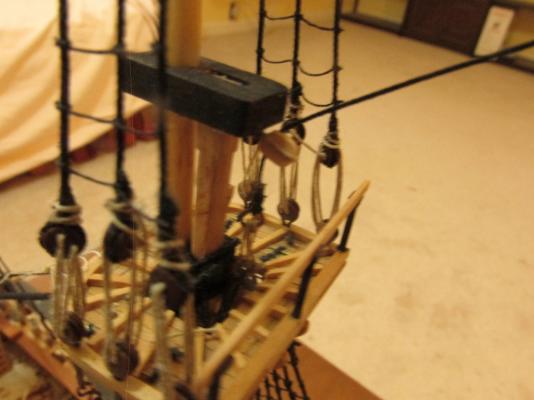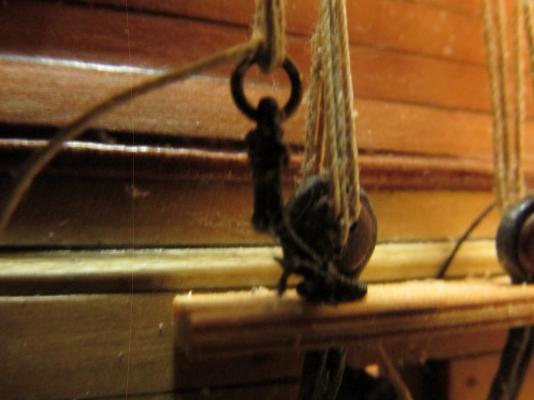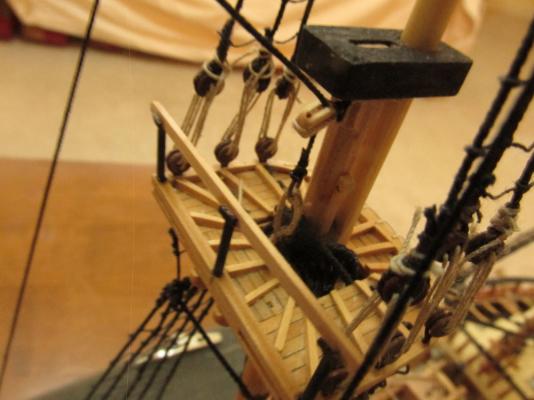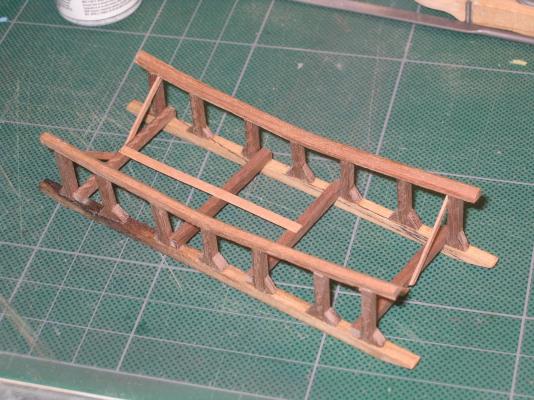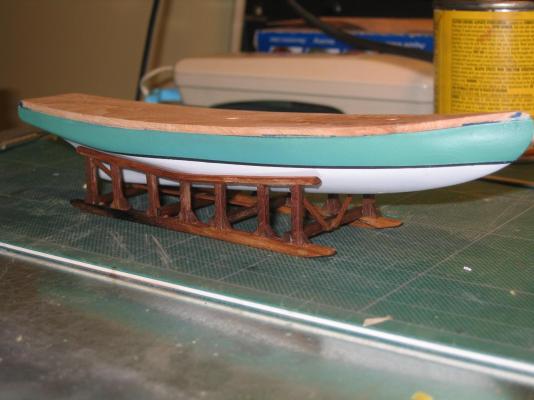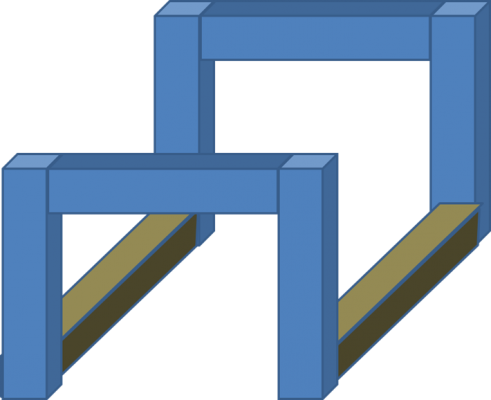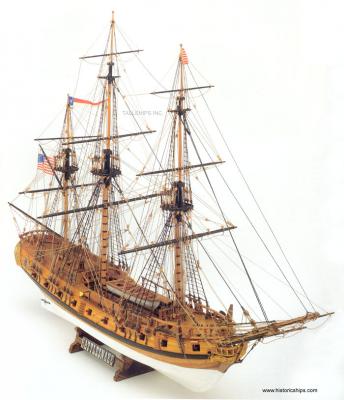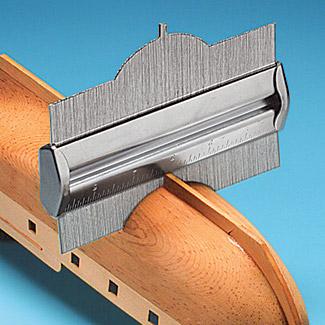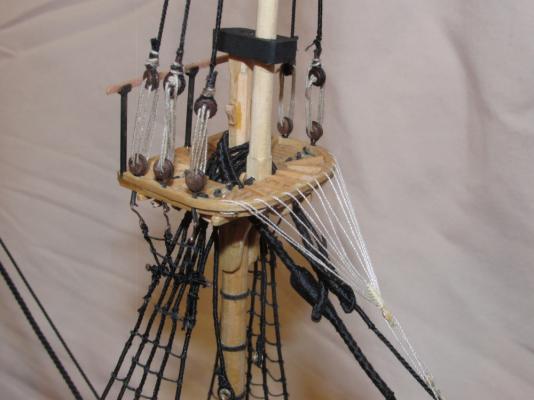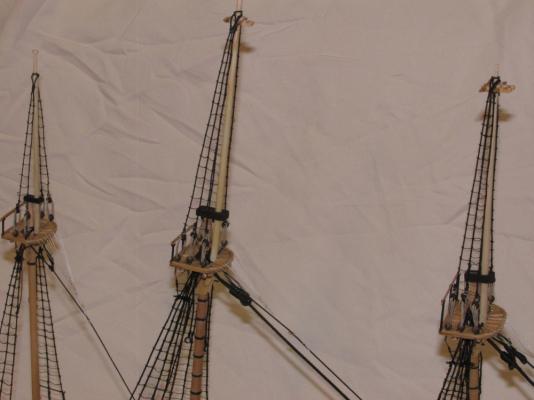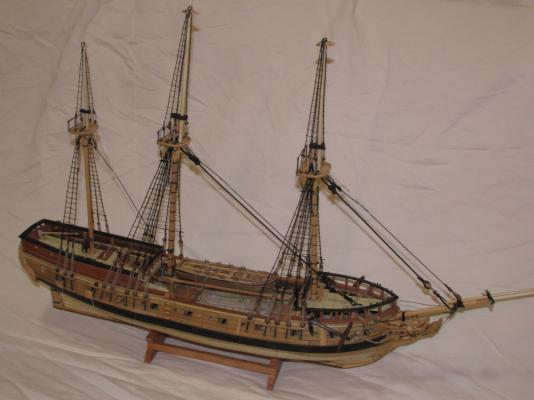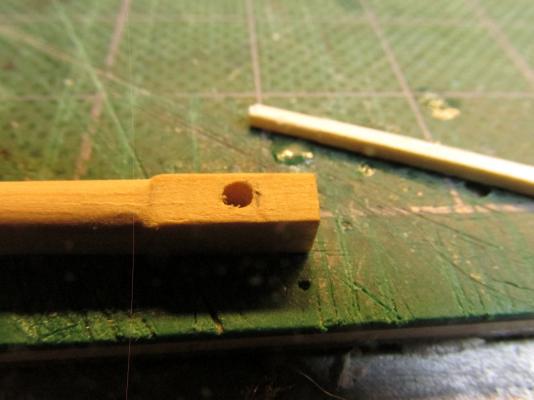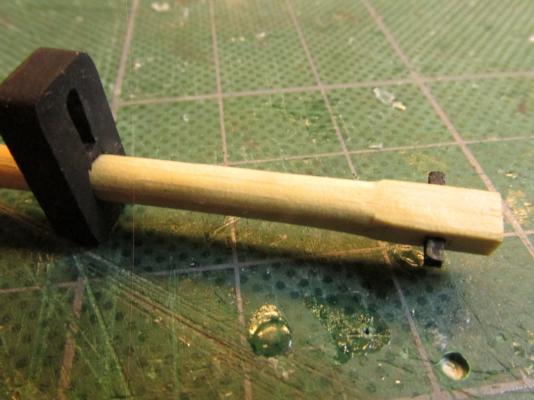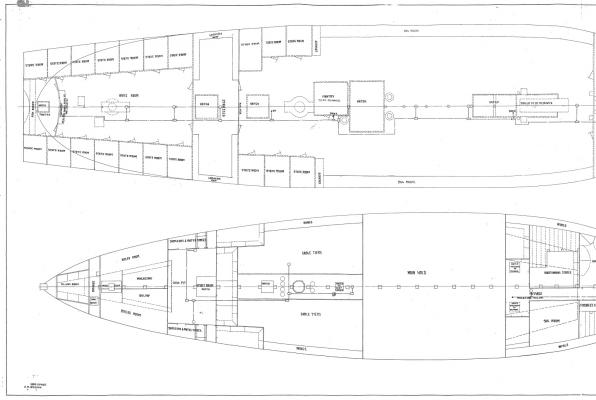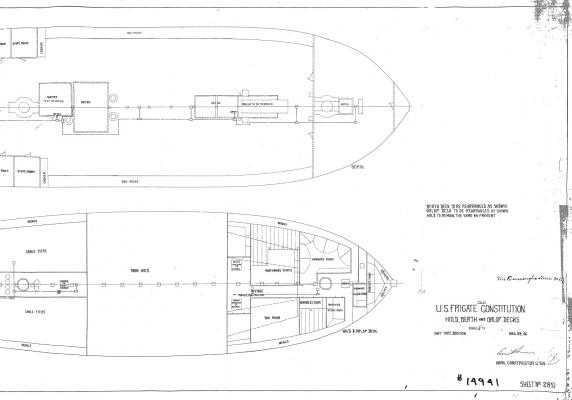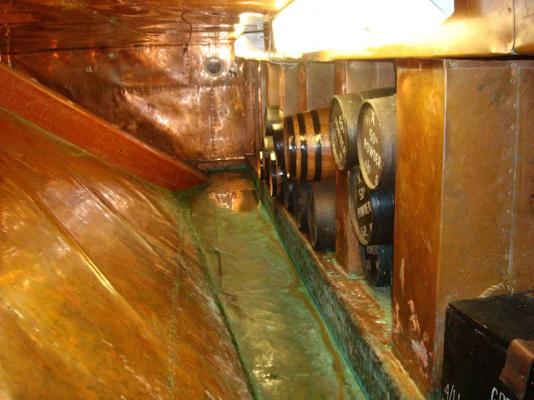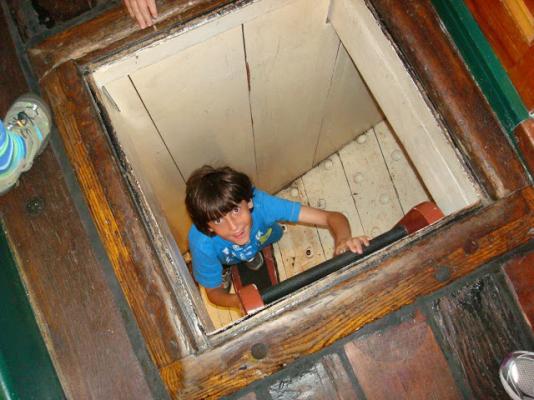-
Posts
2,583 -
Joined
-
Last visited
Content Type
Profiles
Forums
Gallery
Events
Everything posted by JSGerson
-
I wanted to make the shackle from thinner stock but as I stated I didn’t have any suitable brass rod, so I improvised and used a paper clip. I did not want to use too fine of wire because it would not have any strength. Because I did have suitable diameter music wire I had a fleeting thought of using that, but dismissed that idea as impractical as it would be too tough to bend to the required tight curves with the tools that I had. As pliable as paperclips are, at this scale, making tight loops was still tricky. I used a pair of closely nailed brads in a piece of wood to wrap the ends around to make the tight loops. Along with other instruments of mass destruction (hammers, needle nose pliers, etc.), the shackle was made…twice. The first one broke due to over manipulation of the metal – metal fatigue. The little hook was a problem. I just could have made it at the size shown with thinner wire but it would have bent too easily at the barest touch so I had to make it bigger.
- 974 replies
-
- rattlesnake
- mamoli
-
(and 1 more)
Tagged with:
-
As you can see, the real thing is a bit more complex than what was provided in the kit. For one, the little loop atop the ring is a moveable shackle and two, there is a little hook which according to Antscherl, is for the “jib sail tack cringle… [which] is a loop of rope formed at the lower forward corner of this sail”). Because my model won’t have sails, the hook will go unused. As an aside, I don’t know what hardware Model Shipways provided in their kit, but their plans show a roller in lieu of the shackle and no hook. Lees does show that variation in his book. To start, I used a 3/64” brass rod to make the initial ring. I wanted to use a 1/32” rod like Antscherl, but did not have one. The difference was within the tolerances provided in Lees’ book.
- 974 replies
-
- rattlesnake
- mamoli
-
(and 1 more)
Tagged with:
-
Having jumped in with both feet in fabricating most of the other components, I decided to give this a crack. I was in luck that both David Antscherl and James Lees agreed as to what it should look like. This illustration is from James Lees’ The Masting and Rigging of English Ships of War 1625-1860.
- 974 replies
-
- rattlesnake
- mamoli
-
(and 1 more)
Tagged with:
-
Jib Traveler The Mamoli kit provided a Jib Traveler. It is a ring component that fits over the Jib Boom and receives the Outer Foremast Stay from the Foremast Top Tree and directs it to a sheave at the tip of the Jib where it ends at the bowsprit cap. It is designed to slide along the Jib Boom adjusting the stay.
- 974 replies
-
- rattlesnake
- mamoli
-
(and 1 more)
Tagged with:
-
The Fore Topmast Backstay was constructed just like the Mizzen Topmast; the ends terminating to a pair of lashed rings coming off the aft deadeye. The Fore Topmast Stay and Preventer Stay each looped around the topmast tree requiring a mouse and passed through the bees – the Stay through the forward opening on the Starboard side and the Preventer through the aft on the Port. From there they terminated at the bow using a pair of single and double blocks. Because the lines pass through the bees, the double block had to be attached to the rope on the model. The other half of the rigging, the single block, the rope, and eye ring were assembled off the model.
- 974 replies
-
- rattlesnake
- mamoli
-
(and 1 more)
Tagged with:
-
The Main Topmast Backstay was constructed the same as the Mizzen Backstay except instead of rings, deadeyes were required. The lower deadeyes were previously installed but unfortunately, the kit came up short by at least two for the backstays. Using the laser cut deadeye kit supplied by Syren Model Ship Company I then preceded to make-up the shortfall. The deadeye kit consisted of two identical side framed layers and a centerpiece layer containing multiple deadeyes; in this case seven. They are to be assembled as a group. Making sure the outside layer had their outside faces facing outwards and the holes were all facing the same direction, the three layers were glued together with CA as directed. A few minutes later, I cut off two deadeyes. The downloaded instructions strongly suggested using a block tumbler but since I didn’t have one and at this stage only needed two deadeyes (so far), they were hand filed and sanded. The holes, which lined up very nicely, were drilled to remove any excess glue and then stained.
- 974 replies
-
- rattlesnake
- mamoli
-
(and 1 more)
Tagged with:
-
The Mizzen Topmast Stay was next. It started at the top of Mizzen Topmast and went to base of the Main Topmast. The backstay was fastened to the Mizzen Topmast with a simple loop through an eye. At the Main Mast, the line passed through a block attached under the mast cap and terminates to a 3mm blackened ring. Another blackened ring was threaded on a served line that wrapped under the fighting top tree. The two rings were lashed together. The stay was full constructed off the model and then installed. Note the lashings shown in the below images are not finalized.
- 974 replies
-
- rattlesnake
- mamoli
-
(and 1 more)
Tagged with:
-
Topmast Stays and Backstays Working from the stern forward, the Mizzen Backstay was the first to be installed. The stay was split where it fits over the topmast and terminates at the sides of the hull. The bitter ends were served and looped through a blackened ring and seized. Another line, this one very short and fully served, came off the base of the most aft deadeye and also terminated to a ring like the backstay. These rings were then lashed together
- 974 replies
-
- rattlesnake
- mamoli
-
(and 1 more)
Tagged with:
-
You'll have to show us the progress pictures of the display
- 264 replies
-
- rattlesnake
- model shipways
-
(and 1 more)
Tagged with:
-
Very, very nice, you should be proud, and you did it in under two years. I'm still at it, six years and counting. Now you need a nice case and a prominent spot to show it off. Jonathan
- 264 replies
-
- rattlesnake
- model shipways
-
(and 1 more)
Tagged with:
-
- 264 replies
-
- rattlesnake
- model shipways
-
(and 1 more)
Tagged with:
-
I think this is what Martin is referring to. Its a crude rendering but with a few added cross supports, taper the top edge, and maybe add a decoration or two, it would be simple to make, no gauge to buy, and most of all, do the job.
- 264 replies
-
- rattlesnake
- model shipways
-
(and 1 more)
Tagged with:
-
I too have my misgivings about those keel pedestals. Unless you built the hull to take the screws from the pedestal and hold them strong, I believe to cradle is the way to go, If you are referring to the type of stand shown in this Mamoli image, a simple way to get the shape of the hull is to use a contour gauge. The one shown is from Micro-Mark. Just transfer the contour to slabs of wood and use a jig-saw.
- 264 replies
-
- rattlesnake
- model shipways
-
(and 1 more)
Tagged with:
-
Thank you for the wonderful mini-tutorial. This is why I love reading your build log. Jonathan
- 277 replies
-
- model shipways
- 18th century longboat
-
(and 1 more)
Tagged with:
-
B.E. thanks for the soldering complement, especially from you. Also thanks for the tip on seizing the stays, it's greatly appreciated. Jonathan
- 974 replies
-
- rattlesnake
- mamoli
-
(and 1 more)
Tagged with:
-
Out of curiosity, how did you get such beautiful consistent square cuts? Are you an expert X-Acto knife user or do you have a specialty tool you used?
- 277 replies
-
- model shipways
- 18th century longboat
-
(and 1 more)
Tagged with:
-
- 974 replies
-
- rattlesnake
- mamoli
-
(and 1 more)
Tagged with:
-
To install the topmasts, the fid needs to be fitted into the masts. Per the practicum, Mr. Hunt simple glued square piece of ebony to simulate the fid. I chose to actual put them through the masts to ensure a good mechanical joint. It wouldn’t do well for the simulated fib’s glue joint to fail due to the tension of all the lines. It would be a mess to fix. Since I didn’t have any ebony, painted boxwood was used. I made sure that the fid was no more than 1/3 the width of the top mast. You may notice that the fid is square in cross section and the hole is round. Here is a case where one does fit a square peg in a round hole! The very slight gap between the fids and the holes vanishes unless one uses a very strong magnifying glass and even then it’s hard to see.
- 974 replies
-
- rattlesnake
- mamoli
-
(and 1 more)
Tagged with:
-
I traded some Constitution plan images with DanO recently and found this 1906 plan drawing of the Orlop deck in the images he sent me. They were larger than the site would allow, so I've re-sized them to the max the site does allow. I don't know if you have it, but you got now.
- 572 replies
-
- constitution
- frigate
-
(and 1 more)
Tagged with:
-
From: A Sailor's Life for Me (an educational site for young minds) I thought the illustration might be of some use...maybe.
- 572 replies
-
- constitution
- frigate
-
(and 1 more)
Tagged with:
-
Mine predates yours. Have have model 212...sigh 8-(
- 277 replies
-
- model shipways
- 18th century longboat
-
(and 1 more)
Tagged with:
-
Like I said, I have an older version Dremel drill stand. Nothing rotates; you have to slide the head completely off the vertical pole and re-attach it in the horizontal position using a different opening in the head. I guess that's why they made a newer version. 8-(
- 277 replies
-
- model shipways
- 18th century longboat
-
(and 1 more)
Tagged with:
-
I have an older version of the Dremel drill press than you and it only has two positions: vertical and horizontal. Obviously you were able to rotate your drill 45 degrees. After going online and looking at the newer Dremel drill press, I still can't see the mechanism that allowed you to set the drill to 45 degrees. Is there something I don't know?
- 277 replies
-
- model shipways
- 18th century longboat
-
(and 1 more)
Tagged with:
-
Found these images of the powder room. I didn't know if you had them. The first one is the powder room the second is the scuttle to it. You will notice the room is copper clad which should add some interest to your model. I assume that the cladding prevents static charges so things don't go bump in the night. Jonathan
- 572 replies
-
- constitution
- frigate
-
(and 1 more)
Tagged with:
About us
Modelshipworld - Advancing Ship Modeling through Research
SSL Secured
Your security is important for us so this Website is SSL-Secured
NRG Mailing Address
Nautical Research Guild
237 South Lincoln Street
Westmont IL, 60559-1917
Model Ship World ® and the MSW logo are Registered Trademarks, and belong to the Nautical Research Guild (United States Patent and Trademark Office: No. 6,929,264 & No. 6,929,274, registered Dec. 20, 2022)
Helpful Links
About the NRG
If you enjoy building ship models that are historically accurate as well as beautiful, then The Nautical Research Guild (NRG) is just right for you.
The Guild is a non-profit educational organization whose mission is to “Advance Ship Modeling Through Research”. We provide support to our members in their efforts to raise the quality of their model ships.
The Nautical Research Guild has published our world-renowned quarterly magazine, The Nautical Research Journal, since 1955. The pages of the Journal are full of articles by accomplished ship modelers who show you how they create those exquisite details on their models, and by maritime historians who show you the correct details to build. The Journal is available in both print and digital editions. Go to the NRG web site (www.thenrg.org) to download a complimentary digital copy of the Journal. The NRG also publishes plan sets, books and compilations of back issues of the Journal and the former Ships in Scale and Model Ship Builder magazines.



